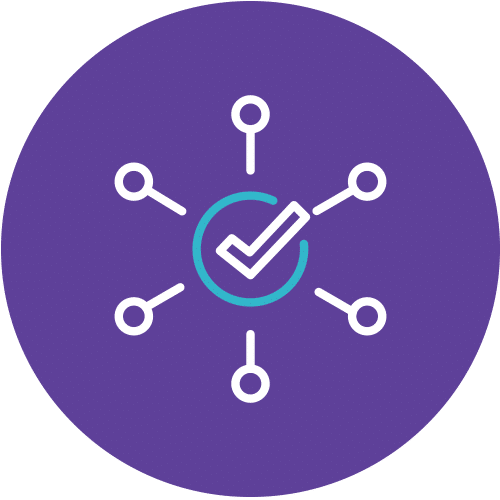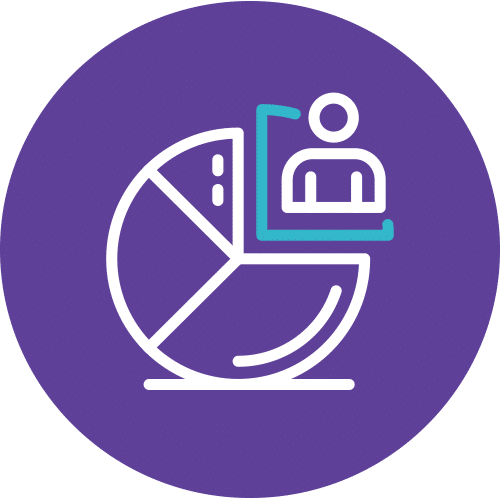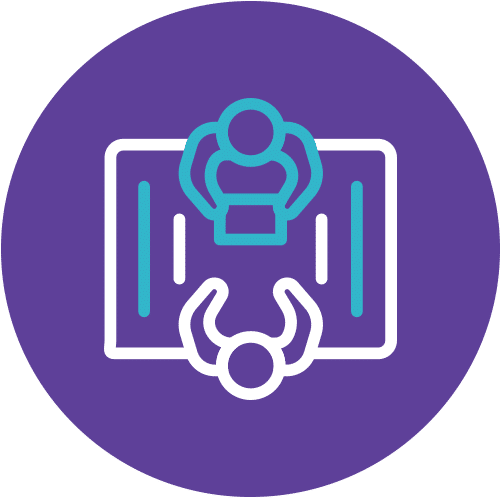Become a Certified Information Systems Security Professional
Are you ready to take your career in Information Technology to the next level? Look no further – our Certified Information Systems Security Professional (CISSP) course is your gateway to becoming a certified information systems security professional.
Unlocking a World of Security
In this course, you’ll delve into the core concepts of confidentiality, integrity, and availability, equipping you to understand and apply security governance principles. From compliance and legal issues to risk management and threat modeling, you’ll gain invaluable knowledge that will not only elevate your career but also help you safeguard vital information assets.
Comprehensive Learning
Our program uses interactive lectures, practical exercises, and discussions to ensure you grasp the intricate world of security and risk management. Whether you’re an aspiring security pro or an IT enthusiast, our CISSP course will empower you with the skills and insights needed to thrive in today’s fast-paced corporate landscape.
Join the Ranks of the Elite: Take the first step towards becoming a Certified Information Systems Security Professional with Info Trek’s CISSP course. Your journey to excellence in information security starts here.
Enroll now and secure your future as a certified information systems security professional!
Course Details
Course Code: CISSP; Instructor-led
Audience
This course is designed for Information Technology Professionals who wish to attain CISSP certification and facilitate their growth as a security professional
Prerequisites
- Basic data modeling, user experience design, requirements analysis, and process analysis skills.
- A personal growth mindset and are comfortable using technology to solve business problems.
- An understanding of the operational need and have a vision of the desired outcome. They approach problems with phased and iterative strategies.
Methodology
This program will be conducted with interactive lectures, PowerPoint presentation, discussion and practical exercise.
Course Objectives
Upon completion of this program, participants should be able to:
- Concepts of confidentiality, integrity and availability
- Security threats, safeguards, vulnerabilities and attacks
- Risk management processes
- Building blocks of information security
- Security awareness programs
- IS audit process
Security management entails the identification of an organization’s information assets and the development, documentation, and implementation of policies, standards, procedures, and guidelines.
Management tools such as data classification and risk assessment/analysis are used to identify threats, classify assets, and to rate system vulnerabilities so that effective controls can be implemented
Outlines
Module 1: Security and Risk Management (Security, Risk, Compliance, Law, Regulations, and Business Continuity)
- Understand and apply concepts of confidentiality, integrity and availability
- Apply security governance principles through:
- Alignment of security function to strategy, goals, mission, and objectives
- (e.g., business case, budget and resources)
- Organizational processes (e.g., acquisitions, divestitures, governance
- committees)
- Security roles and responsibilities
- Control frameworks
- Due care
- Due diligence
- Compliance
- Legislative and regulatory compliance
- C.2 Privacy requirements compliance
- Understand legal and regulatory issues that pertain to information security in a global context
- Computer crimes
- Licensing and intellectual property (e.g., copyright, trademark, digital rights
- Import/export controls
- Trans-border data flow
- Privacy
- Data breaches
- Understand professional ethics
- Exercise (ISC)² Code of Professional Ethics
- Support organization’s code of ethics
- Develop and implement documented security policy, standards, procedures, and guidelines
- Understand business continuity requirements
- Develop and document project scope and plan
- Conduct business impact analysis
- Contribute to personnel security policies
- Employment candidate screening (e.g., reference checks, education verification)
- Employment agreements and policies
- Employment termination processes
- Vendor, consultant, and contractor controls
- Compliance
- Privacy
- Understand and apply risk management concepts
- Identify threats and vulnerabilities
- Risk assessment/analysis (qualitative, quantitative, hybrid)
- Risk assignment/acceptance (e.g., system authorization)
- Countermeasure selection
- Implementation
- Types of controls (preventive, detective, corrective, etc.)
- Control assessment
- Monitoring and measurement
- Asset valuation
- Reporting
- Continuous improvement
- Risk frameworks
- Understand and apply threat modeling
- Identifying threats (e.g., adversaries, contractors, employees, trusted
- partners)
- Determining and diagramming potential attacks (e.g., social engineering,
- spoofing)
- Performing reduction analysis
- Technologies and processes to remediate threats (e.g., software architecture
- and operations)
- Integrate security risk considerations into acquisition strategy and practice
- Hardware, software, and services
- Third-party assessment and monitoring (e.g., on-site assessment, document
- exchange and review, process/policy review)
- Minimum security requirements
- Service-level requirements
- Establish and manage information security education, training, and awareness
- Appropriate levels of awareness, training, and education required within
- organization
- Periodic reviews for content relevancy
Module 2: Asset Security (Protecting Security of Assets)
- Classify information and supporting assets (e.g., sensitivity, criticality)
- Determine and maintain ownership (e.g., data owners, system owners, business/mission owners)
- Protect privacy
- Data owners
- Data processers
- Data remanence
- Collection limitation
- Ensure appropriate retention (e.g., media, hardware, personnel)
- Determine data security controls (e.g., data at rest, data in transit)
- Baselines
- Scoping and tailoring
- Standards selection
- Cryptography
- Establish handling requirements (markings, labels, storage, destruction of sensitive information)
Module 3: Security Engineering (Engineering and Management of Security)
Implement and manage engineering processes using secure design principles
Understand the fundamental concepts of security models (e.g., Confidentiality,
Integrity, and Multi-level Models)
Select controls and countermeasures based upon systems security evaluation models
Understand security capabilities of information systems (e.g., memory protection,
virtualization, trusted platform module, interfaces, fault tolerance)
Assess and mitigate the vulnerabilities of security architectures, designs, and solution elements
- Client-based (e.g., applets, local caches)
- Server-based (e.g., data flow control)
- Database security (e.g., inference, aggregation, data mining, data analytics, warehousing)
- Large-scale parallel data systems
- Distributed systems (e.g., cloud computing, grid computing, peer to peer)
- Cryptographic systems
- Industrial control systems (e.g., SCADA)
- Assess and mitigate vulnerabilities in web-based systems (e.g., XML, OWASP)
- Assess and mitigate vulnerabilities in mobile systems
- Assess and mitigate vulnerabilities in embedded devices and cyber-physical
- systems (e.g., network-enabled devices, Internet of things (loT))
- Apply cryptography
- Cryptographic life cycle (e.g., cryptographic limitations, algorithm/protocol governance)
- Cryptographic types (e.g., symmetric, asymmetric, elliptic curves)
- Public Key Infrastructure (PKI)
- Key management practices
- Digital signatures
- Digital rights management
- Non-repudiation
- Integrity (hashing and salting)
- Methods of cryptanalytic attacks (e.g., brute force, cipher-text only, known plaintext)
- Apply secure principles to site and facility design
- Design and implement physical security
- Wiring closets
- Server rooms
- Media storage facilities
- Evidence storage
- Restricted and work area security (e.g., operations centers)
- Data center security
- Utilities and HVAC considerations
- Water issues (e.g., leakage, flooding)
- Fire prevention, detection and suppression
Module 4: Communication and Network Security (Designing and Protecting Network Security)
- Apply secure design principles to network architecture (e.g., IP & non-IP protocols, segmentation)
- OSI and TCP/IP models
- IP networking
- Implications of multilayer protocols (e.g., DNP3)
- Converged protocols (e.g., FCoE, MPLS, VoIP, iSCSI)
- Software-defined networks
- Wireless networks
- Cryptography used to maintain communication security
- Secure network components
- Operation of hardware (e.g., modems, switches, routers, wireless access points, mobile devices)
- Transmission media (e.g., wired, wireless, fiber)
- Network access control devices (e.g., firewalls, proxies)
- Endpoint security
- Content-distribution networks
- Physical devices
- Design and establish secure communication channels
- Voice
- Multimedia collaboration (e.g., remote meeting technology, instant messaging)
- Remote access (e.g., VPN, screen scraper, virtual application/desktop, telecommuting)
- Data communications (e.g., VLAN, TLS/SSL)
- Virtualized networks (e.g., SDN, virtual SAN, guest operating systems, port isolation)
- Prevent or mitigate network attacks
Module 5: Identity and Access Management (Controlling Access and Managing Identity)
- Control physical and logical access to assets
- Information
- Systems
- Devices
- Facilities
- Manage identification and authentication of people and devices
- Identity management implementation (e.g., SSO, LDAP)
- Single/multi-factor authentication (e.g., factors, strength, errors, biometrics)
- Accountability
- Session management (e.g., timeouts, screensavers)
- Registration and proofing of identity
- Federated identity management (e.g., SAML)
- Credential management systems
- Integrate identity as a service (e.g., cloud identity)
- Integrate third-party identity services (e.g., on premise)
- Implement and manage authorization mechanisms
- Role-Based Access Control (RBAC) methods
- Rule-based access control methods
- Mandatory Access Control (MAC)
- Discretionary Access Control (DAC)
- Prevent or mitigate access control attacks
- Manage the identity and access provisioning lifecycle (e.g., provisioning, review)
Module 6: Security Assessment and Testing (Designing, Performing, and Analyzing
- Design and validate assessment and test strategies
- Conduct security control testing
- Vulnerability assessment
- Penetration testing
- Log reviews
- Synthetic transactions
- Code review and testing (e.g., manual, dynamic, static, fuzz)
- Misuse case testing
- Test coverage analysis
- Interface testing (e.g., API, UI, physical)
- Collect security process data (e.g., management and operational controls)
- Account management (e.g., escalation, revocation)
- Management review
- Key performance and risk indicators
- Backup verification data
- Training and awareness
- Disaster recovery and business continuity
- Analyze and report test outputs (e.g., automated, manual)
- Conduct or facilitate internal and third-party audits
Module 7: Security Operations (Foundational Concepts, Investigations, Incident Management, and Disaster Recovery)
- Understand and support investigations
- Evidence collection and handling (e.g., chain of custody, interviewing)
- Reporting and documenting
- Investigative techniques (e.g., root-cause analysis, incident handling)
- Digital forensics (e.g., media, network, software, and embedded devices)
- Understand requirements for investigation types
- Operational
- Criminal
- Civil
- Regulatory
- Electronic discovery (eDiscovery)
- Conduct logging and monitoring activities
- Intrusion detection and prevention
- Security information and event management
- Continuous monitoring
- Egress monitoring (e.g., data loss prevention, steganography, watermarking)
- Secure the provisioning of resources
- Asset inventory (e.g., hardware, software)
- Configuration management
- Physical assets
- Virtual assets (e.g., software-defined network, virtual SAN, guest operating systems)
- D.5 Cloud assets (e.g., services, VMs, storage, networks)
- D.6 Applications (e.g., workloads or private clouds, web services, software as a service)
- Understand and apply foundational security operations concepts
- Need-to-know/least privilege (e.g., entitlement, aggregation, transitive trust)
- Separation of duties and responsibilities
- Monitor special privileges (e.g., operators, administrators)
- Job rotation
- Information lifecycle
- Service-level agreements
- Employ resource protection techniques
- Media management
- Hardware and software asset management
- Conduct incident management
- Detection
- Response
- Mitigation
- Reporting
- Recover
- Remediation
- Lessons learned
- Operate and maintain preventative measures
- Firewalls
- Intrusion detection and prevention systems
- Whitelisting/Blacklisting
- Third-party security services
- Sandboxing
- Honeypots/Honeynets
- Anti-malware
- Implement and support patch and vulnerability management
- Participate in and understand change management processes (e.g. Versioning, baselining, security impact analysis)
- Implement recovery strategies
- Backup storage strategies (e.g., offsite storage, electronic vaulting, tape rotation)
- Recovery site strategies
- Multiple processing sites (e.g., operationally redundant systems)
- System resilience, high availability, quality of service, and fault tolerance
- Implement disaster recovery processes
- Response
- Personnel
- Communications
- Assessment
- Restoration
- Training and awareness
- Test disaster recovery plans
- Read-through
- Walkthrough
- Simulation
- Parallel
- Full interruption
- Participate in business continuity planning and exercises
Implement and manage physical security
Perimeter (e.g., access control and monitoring)
- Internal security (e.g., escort requirements/visitor control, keys and locks)
- Participate in addressing personnel safety concerns (e.g., duress, travel, monitoring)
Module 8: Software Development Security (Understanding, Applying, and Enforcing Software Security)
- Understand and apply security in the software development lifecycle
- Development methodologies (e.g., Agile, Waterfall)
- Maturity models
- Operation and maintenance
- Change management
- Integrated product team (e.g., DevOps)
- Enforce security controls in development environments
- Security of the software environments
- Security weaknesses and vulnerabilities at the source-code level (e.g., buffer overflow, escalation of privilege, input/output validation)
- Configuration management as an aspect of secure coding
- Security of code repositories
- Security of application programming interfaces
- Assess the effectiveness of software security
- Auditing and logging of changes
- Risk analysis and mitigation
- Acceptance testing
- Assess security impact of acquired software










